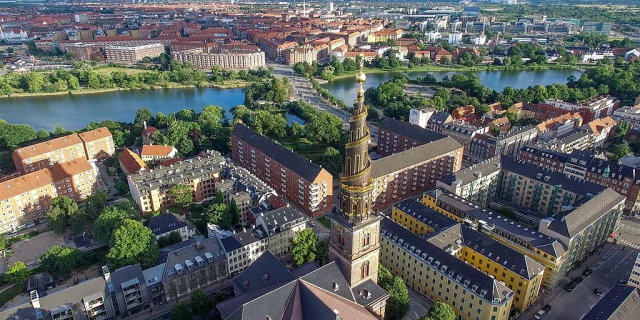Kastellet
( Kastellet, Copenhagen )Kastellet (Danish pronunciation: [kʰæˈsteˀlð̩]; transl. "The Citadel") is a citadel located in Copenhagen, Denmark. It is one of the best preserved fortresses in Northern Europe. It is constructed in the form of a pentagon with bastions at its corners. Kastellet was continuous with the ring of bastioned ramparts which used to encircle Copenhagen but of which only the ramparts of Christianshavn remain today.
A number of buildings are located within the grounds of Kastellet, including the Citadel Church as well as a windmill. The area houses various military activities but it also serves as a public park and a historic site.
 The Citadel in 1648, with an enclosed dock
The Citadel in 1648, with an enclosed dockKing Christian IV of Denmark initiated Kastellet's construction in 1626 with the building of an advanced post, St. Anne's Redoubt (Danish: Sankt Annæ Skanse), on the coast north of the city. The redoubt guarded the entrance to the port, together with a blockhouse that was constructed north of Christianshavn, which had just been founded on the other side of the strait between Zealand and Amager. At that time the fortifications only reached as far north as present day Nørreport station, and then returned south east to meet the coast at Bremerholm, the Royal Shipyard. However, part of the king's plan was to expand the area of the fortified city by abandoning the old East Rampart and instead extend the rampart straight north to connect it to St. Anne's Redoubt. This plan was not completed until the mid-1640s, shortly after King Frederick III succeeded King Christian IV.
The new citadel Kastellet in 1880 with Kommandantgården to the right
Kastellet in 1880 with Kommandantgården to the rightAfter the Swedish siege of Copenhagen (1658–1660) the Dutch engineer Henrik Rüse was called in to help rebuild and extend the construction. The fortification was named Citadellet Frederikshavn (transl. The Citadel Frederik's harbor), but it is better known as Kastellet ("the Citadel").[1]
Kastellet was part of the defence of Copenhagen against the United Kingdom in the Battle of Copenhagen (1807).
Christen Købke (1810–1848), Danish painter associated with the Golden Age of Danish Painting, grew up in Kastellet and made many paintings of the area.
During the German invasion of Denmark on 9 April 1940, German troops landing at the nearby harbor captured The Citadel without resistance.
Kastellet was renovated 1989–1999 with funds from the A.P. Møller and Wife Chastine McKinney Møllers General Fund.




































Add new comment